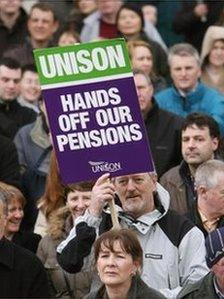Local Government Pension Scheme
- Published

The local government scheme has more active members than any other in the UK
Which employees does the scheme cover?
It is a scheme for employees working in local government or working for other employers participating in the scheme, and for some councillors.
How many sections are there?
It is an umbrella scheme with one set of benefits, but the pensions are paid for by separate underlying investment funds.
There are three schemes, one covering England and Wales, one covering Scotland and one covering Northern Ireland.
The schemes are administered by 100 administering authorities: 88 in England and Wales, 11 in Scotland and one in Northern Ireland.
How many active, deferred and retired members do they have?
At the end of March 2009, in England and Wales there were 1.81 million active contributors; 1.16 million pensioners and 1.21 million deferred members - former employees who have yet to draw their pensions.
The Scottish scheme is big too. As of 31 March 2009 it had 225,035 active members; 87,390 deferred members and 147,961 pensioners and dependants.
What are the principal benefits?
For service before April 2008, the annual pension is based on an accrual rate of 1/80th of final salary per year of membership plus a 3/80ths lump sum.
The scheme changed for all members in April 2008.
From then on, for all members both old and new, the annual pension has been based on a faster accrual rate of 1/60th per year of membership.
For all members the normal retirement age is now 65.

Proposed changes let to national strikes in 2006
Before 1 April 2009 in Scotland and Northern Ireland, the benefits were a pension based on an accrual rate of 1/80th of final salary for each year of membership plus an automatic lump sum of 3/80ths of final salary.
These schemes then came into line with the English and Welsh versions.
What percentage of salary do employees and employers pay?
In England, Wales and Northern Ireland, employees pay a variable contribution rate based on salary.
It ranges from 5.5% for those earning less than £12,600 to 7.5% for those with earnings in excess of £78,700.
The rate of employers' contributions is set at each fund triennial valuation and varies from employer to employer.
In Scotland, employee contributions range from 5.5% to 12%.
What are the funding costs of the scheme?
In 2008, the Government Actuary set the total contribution rate at 20.6% in England and Wales for existing members and 18.2% for new members.
Within that the average employee rate was set at 6.3% in both cases.
The employer rate is 14.3% for existing members and 11.9% for new entrants.
In Scotland, the average future service cost for the scheme applying from April 2009 was estimated by the Government Actuary as being 19.6% of payroll.
With employee contributions set at an average of 6.3% this put the average employer contribution rate at 13.3%.
Is the scheme funded or unfunded?
Funded. The pensions are paid for by underlying investment funds, not out of general taxation.
Is the scheme deemed to be in deficit or surplus?
In 2007 there was a deficit of £27bn for the funds in England and Wales.
"The funds in England, Wales and Northern Ireland are currently undergoing their triennial valuations, as at 31 March 2010," said Terry Edwards of the local government employers organisation.
"The outcome is likely to be that many of the funds will currently be in deficit although some may be in surplus - we will not know until the valuation reports are issued.
"The funds in Scotland undergo their valuations next year, at 31 March 2011," he added.
What is the value of the scheme's assets and its liabilities?

The LGPS is funded, like the universities' scheme but unlike the other public service pension schemes
At the last scheme valuation in 2007, scheme assets were valued at £132bn, with pension liabilities valued at £159bn.
What is the average pension in payment?
In England and Wales the average pension in payment at March 2009 was £4,044 a year.
Have there been any changes or reforms to the scheme in recent years?
Yes. The new local government pension scheme in England and Wales was introduced from April 2008 and in Scotland and Northern Ireland from April 2009.
Pension increases are to be linked to the consumer prices index (CPI) instead of the retail prices index (RPI) from April 2011, as announced in the emergency Budget statement.
An old rule providing an early unreduced pension in some circumstances at 60 - "the rule of 85" - was abolished in 2006.
Are there any further changes in the pipeline?
"The chancellor has made it clear that government must consider options for reform that are fair to the taxpayer and to people who work in the public sector," said the communities and local government department (DCLG).
"An independent public service pension commission is currently reviewing public service pensions to assess the current provision, identify problems and consider the objectives that should set the framework for any change."
Source: DCLG and the local government employers organisation.